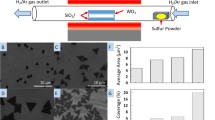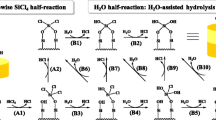Abstract
The deposition rate of tungsten selectively prepared by hydrogen reduction of WF6 was measured, and the encroachment produced by inherent silicon reduction even in the presence of H2 gas was examined by cross-sectional TEM and SEM. In the WF6-H2 system, the degree of encroachment is not explained by the Si reduction reaction alone, but is rather related to the Si reduction time decreasing with increasing deposition rate of H2-reduced tungsten film, because a blocking layer is formed above the Si-reduced tungsten. This results in a lesser degree of encroachment. Consequently a high deposition rate of H2-reduced tungsten can decrease the degree of encroachment. By calculation, a thickness of 6.8–13.3 nm is necessary for H2-reduced tungsten to prevent WF6 gas from reacting with Si.
Similar content being viewed by others
References
N. E. Miller andI. Beinglass,Solid State Technol. 23 (1980) 79.
J.-O. Carlsson andM. Boman,J. Vac. Sci. Technol. A3 (1985) 2298.
B. W. Shen, G. C. Smith, J. M. Anthony andR. J. Matyi,ibid. B4 (1986) 1369.
M. L. Green, Y. S. Ali andT. Boone, in Tungsten and Other Refractory Metals for VLSI Applications II, edited by E. K. Broabent (Materials Research Society, Pittsburgh, 1987) p. 85.
R. S. Blewer, T. J. Headley andM. E. Tracy, in Tungsten and Other Refractory Metals for VLSI Applications III, edited by V. A. Wells (Materials Research Society, Pittsburgh, 1988) p. 115.
W. A. Bryant,J. Electrochem. Soc. 125 (1978) 1534.
E. K. Broadbent andW. A. Stacy,Solid State Technol. 28 (1985) 51.
K. Y. Ahn, P. M. Fryer, J. M. E. Harper, R. V. Joshi andC. W. Miller, in Tungsten and Other Refractory Metals for VLSI Applications IV, edited by R. S. Blewer and C. M. McConica (Materials Research Society, Pittsburgh, 1989) p. 35.
R. H. Wilson andR. W. Stoll, in Tungsten and Other Refractory Metals for VLSI Applications III, edited by V. A. Wells (Materials Research Society, Pittsburgh, 1988) p. 311.
H. L. Park, C. D. Park andJ. S. Chun,Thin Solid Films 166 (1988) 37.
R. Chow, S. Kang, W. R. Harshbarger andM. Susoeff, in Tungsten and Other Refractory Metals for VLSI Applications II, edited by E. K. Broabent (Materials Research Society, Pittsburgh, 1987) p. 137.
I. A. Blech andE. S. Meieran,J. Appl. Phys. 38 (1967) 2913.
E. K. Broadbent, A. E. Morgan, J. M. Deblasi, P. Vander Putte, A. Reader, B. Coulman, B. J. Burrow andD. K. Sadana, in Tungsten and Other Refractory Metals for VLSI Applications, edited by R. S. Blewer (Materials Research Society, Pittsburgh, 1986) p. 63.
Author information
Authors and Affiliations
Rights and permissions
About this article
Cite this article
Park, Y.W., Kim, I., Park, C.O. et al. Effects of deposition rate on the encroachment in tungsten films reduced by H2 . J Mater Sci 26, 5318–5322 (1991). https://doi.org/10.1007/BF01143227
Received:
Accepted:
Issue Date:
DOI: https://doi.org/10.1007/BF01143227




